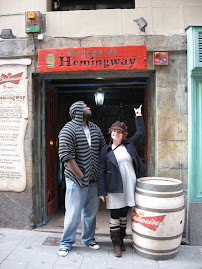_________________
On May 13, 2006, Katherine McCarron, a three year-old autistic girl, was allegedly murdered by her mother, Dr. Karen McCarron, by suffocation. In the months that have followed, however, autism advocates and disability rights organizations have been outraged with the sympathy Dr. McCarron has received in the media for having the "burden" of raising an autistic child. Not Dead Yet argues, "Recent media coverage of mothers being charged with killing or attempting to kill their disabled daughters solicits sympathy and understanding for the heinous acts." In fact, Autism Speaks, a national organization dedicated to "funding global biomedical research into the causes, prevention, treatments, and cure for autism; to raising public awareness about autism and its effects on individuals, families, and society; and to bringing hope to all who deal with the hardships of this disorder," has even produced and published Autism Everyday, a video available online that attempts to show the everyday struggles parents of autistic children face daily.
However, Autism Everyday has came under intense scrutiny in the past couple months for its negative and fatalistic portrayal of autistic children and the struggles parents face when raising autistic children. Critics have charged that this video portrays autistic children as economic and emotional burdens on their families. One alarming part of the documentary shows a mother discussing (in front of her autistic child) how she's contemplated driving herself and her autistic daughter off of the George Washington Bridge. This mother admits that the only reason she hasn't done so already is because of the needs of her "normal" child. I, too, found this video disturbing when I first watched it in late May following my own son's autism diagnosis. I remember too vividly thinking that for these women, "autism" was a death sentence. The tragedy that defined their lives.
A rhetorical analysis based on Kenneth Burke's theory of cluster criticism of the short documentary (it runs approximately 14 minutes long) would supports such criticisms. Specifically, the directors predominately show throughout the movie the burdens and heartbreak associated with raising a child with autism. The mothers interviewed in the documentary make statements that
- they've had to "give up" their entire lives to autism,
- "people have no idea" as to "how difficult life is on a day-to-day basis" for families with autistic children,
- the condition is "heartbreaking,"
- these autistic children are violent, disruptive, and take the joy out of everyday life,
- other siblings suffer due to one child's autism,
- these parents of autistic children are left "angry," "helpless," and "disappointed,"
- these parents have had their children "taken away from them" by autism, and
- these parents "cannot accept that we have to throw away this generation of children" to autism.
Again, such descriptors as "heartbreaking," "angry," "helpless," and "suffering" illustrate the common ideological and rhetorical thread throughout the movie that autistic children are emotional and financial burdens on their families. In fact, the mothers only mention the words "loving" and "hope" in the final minute of the movie and there is no discussion in regard to the children's accomplishments, potentials, or capabilities. The autistic children throughout the movie are portrayed overwhelmingly negative and tragically.
What might be the purpose of funding and distributing a documentary that portrays autism so negatively, especially considering Autism Speaks' mission of "funding global biomedical research [...]; raising public awareness about autism [...]; and to bring hope to all who deal with the hardships of this disorder"? I believe that the rhetoric within the movie answers this question. If we're to accept that producers Lauren Thierry, Jim Watkins, and Eric Solomon selectively choose the footage that was to be used in the final cut, such words as "cure" and "prevention" further the organization's mission--finding a "cure" and "preventing" autism. This movie, then, helps support the Autism Speaks' cause of raising money for autism research aimed at "curing" and "preventing" autism.
Portraying autism as the tragedy that defines one's life is an emotional appeal that plays on the heartstrings (and wallets) of viewers. Would it have been as effective to discuss the biological or behavioral factors that contribute to the frustrations associated with autism? No, probably not. Seeing frustrated and frazzled, white, divorced, middle-aged women is more effective at garnering a "sympathy" response from audiences than seeing women who deal with autism day-in and day-out but live a relatively "normal" life--a life that isn't fatalistically defined by autism. Who would contribute money for a cause that isn't "terrible," "heartbreaking," and "devastating" in every possible way?
Important to note, though, is that it's sentiments like these, that autism is a heartbreaking disorder that leaves parents shattered and children suffering and struggling, that seem to reinforce the ideology that it's okay to murder one's autistic child. These children, it would seem, bring nothing but misery and hopelessness onto their families. This ideological stance argues that murdering the disabled is probably the best thing for the children, their families, and society-at-large. And, it's for this reason that it's important to identify the rhetorical clusters that construct the ideologies of autism.
However, this ideological stance is not indicative of the entire autism communities' approach to autism research, funding, and support. In fact, groups like the Autism Assembly "share the common goal of seeking acceptance for those on the autistic spectrum, who aim to educate about autism, and who are not seeking a cure for autism. This is part of the global autism rights movement." Therefore, if the movie were produced for a different organization, one that supports acceptance and does not support a "cure" for autism, the rhetorical "clusters" might've been completely different.








2 comments:
Your blog keeps getting better and better! Your older articles are not as good as newer ones you have a lot more creativity and originality now keep it up!
Thanks. I think it's kinda obvious when I was writing on the dissertation and when I wasn't. Hopefully, now that I'm done with school, the posts will get better. :)
Post a Comment